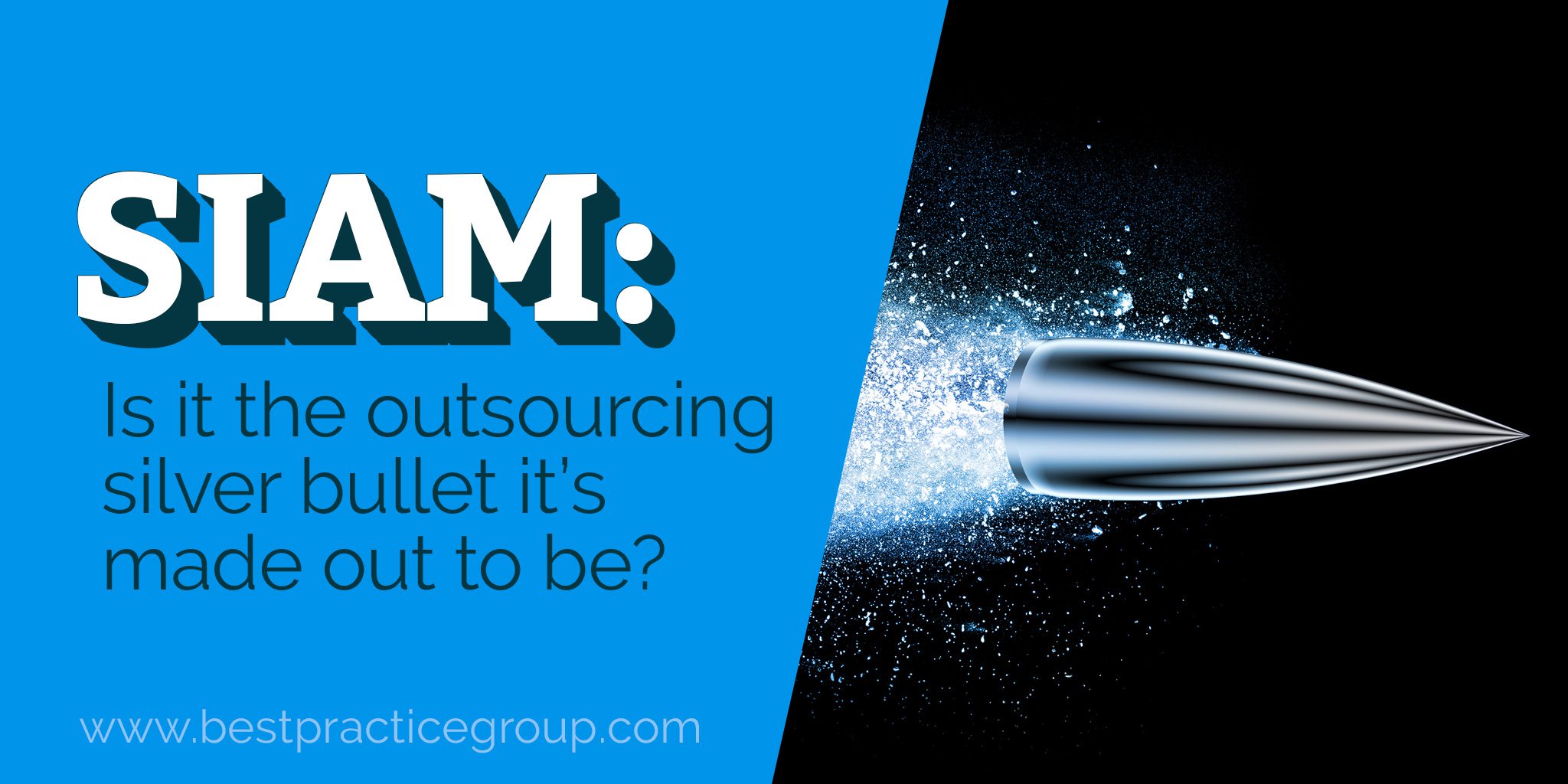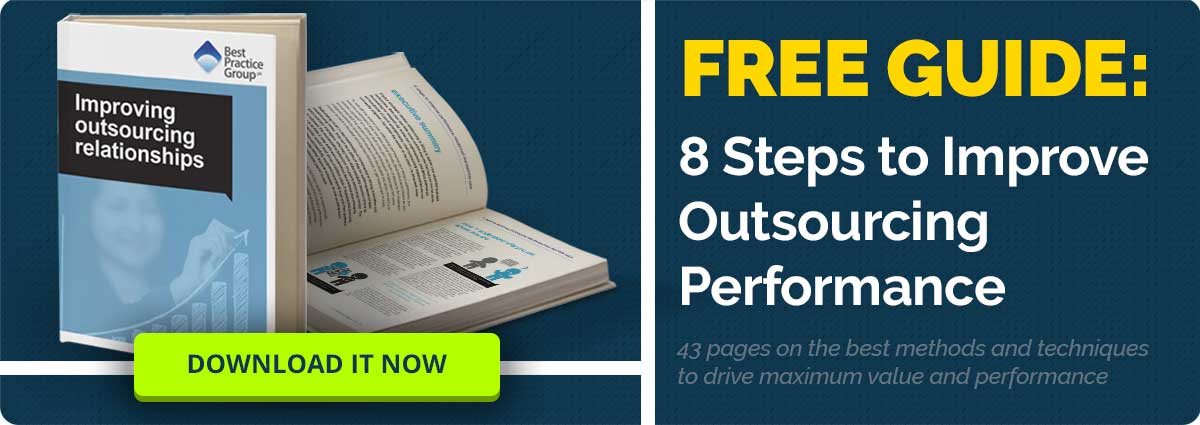
Service integration and management (SIAM) has continued to be something of a buzz-acronym in managed service and outsourcing circles. The way it’s talked about, you might be forgiven for thinking that it’s a silver bullet which in one fell swoop will improve management practices and productivity levels and ensure better control and results from any managed service. But does the evidence stack up to prove this is really the case? Can this concept live up to these heightened expectations? In this article, we discuss whether SIAM really is the solution for performance visibility of managed service solutions that everyone has been looking for.
SIAM is a concept that has been gaining traction in the outsourcing world for some years; it’s the practice of creating a management layer between a client and its multiple contractors to coordinate the entire relationship, becoming the master puppeteer of all its working parts.
The government has been eager for some time to challenge the seemingly monopolistic reign of a few super-massive global companies in the outsourcing field in favour of more competition in the market when it comes to public sector procurement.
They have been advocating for greater involvement in public sector bidding from small outsourcers and managed services providers. SIAM, as a management process and method, would certainly help to coordinate a plethora of smaller providers into achieving one objective: the integrated performance management of multiple providers to achieve a single overriding service objective.
The concept follows this basic thought process: rather than offering your entire series of technology service delivery to one supplier or provider so that you can benefit from a single source of contact and their expertise, you would instead be splitting the service delivery into its salient parts and allocating portions to different expert contractors. By doing so you may:
1. Benefit from more specialised expertise
Large outsourcing organisations may have gravitas, but do they have the real deep domain expertise you need? They may in fact be brilliant in certain areas and weaker in others. If you intelligently split your service delivery into logical parts these can be divided responsibly between a number of smaller specialised companies which are in a better position to offer the expertise that will generate greater innovations and add value to the relationship.
2. Spread the risk
Large organisations sometimes suffer from financial difficulties and takeovers, or could exit the market entirely. By splitting the mechanism for service delivery into a number of smaller portions, with work spread between several suppliers or providers, you potentially minimise the risk and reliance associated with working with a single or small number of suppliers. While some smaller companies may be more susceptible to the cash flow forces that could cause such troubles, this ‘spread the risk for a safer delivery plan’ concept is still a valid one.
3. Gain from the competition
There are many positive aspects to competition, but most of all it keeps prices in check and increases the will to be productive. The more competition there is, the higher the likelihood of efficiencies being implemented, innovations pursued, and value strived for.
IT projects tend to be complex undertakings, requiring a whole host of very specific skills. They lend themselves very well to the use of smaller specialist contractors. However, this does leave the important issue of performance management.
Coordinating a number of different organisations, potentially with varied concepts and calculations when it comes to service level agreements (SLAs) and working practices, can be, at best, challenging. SIAM looks to simplify this through allocation of this task to one top-level team made up of experts from client and contractors. A recent article in Computer Weekly stated: “Such mechanisms are essential to encourage real collaboration across the supplier landscape, which means SIAM has the potential to become the de facto way for IT organisations to deliver joined-up services to the business.”
This layer of management and control – defining responsibility boundaries and best practices – may come in one of four forms:
1. Client in-house. Where a specialist team is created internally within the client’s organisation to act as performance managers.
2. Third-party consultant. The use of a dedicated management consultancy that would either have the in-house capacity and talent themselves or would form a team tailored for the task.
3. Single supplier. When the one supplier you have instructed takes on board the responsibility of coordinating the different areas of service delivery as well as delivering on it themselves.
4. Lead supplier. When one supplier is elevated to manage all others that are instructed on the delivery process as well as delivering their own portion of delivery responsibility.
SIAM as a concept in itself has limited value, it is only when stakeholder goals are aligned and everyone works to the SIAM framework that value can be realised. SIAM as a supplier relationship management plan can, therefore, offer significant benefits. Clear lines of accountability, clear outcomes and a well-defined governance model are essential. The make-up of the SIAM team is also important and needs top-level talented individuals from client and suppliers to offer knowledge and insights, minimise risk and maximise opportunities. The team’s practices must also include benchmarking, performance monitoring, stakeholder engagement and relationship building to encourage cooperation and a collaborative approach to the success of the different areas of technology service delivery.
Five ‘must-know’ facts about SIAM
1. SIAM in itself is not the solution.
People and process changes on their own will not necessarily change the effectiveness of your supplier management. SIAM requires a considered commitment to invest in collaborative management using the most skilled of senior team members with a full spectrum of project and supplier knowledge, tasked and authorised to do whatever is necessary to achieve the project’s desired outcome.
2. Collaboration is everything
To get the most from the group of specialist providers that you have selected you must involve them, give them a seat at the table and listen to them. Two minds are better than one, three even more so.
3. Suppliers should know their place
The meaning is far more benign than this title would suggest, while also being vitally important. The suppliers you hope to collaborate with, and get the most from, should understand their place in cross-stakeholder relationships – their dependencies, what they contribute and how important it is to the success of the delivery process. This will also help them to understand how their role fits into the project schedule – when they are needed and why. Openness and transparency are always beneficial to cross-party stakeholders, and certainly to the success of the relationships that drive them.
4. Take a strategic as well as an operational perspective
Supplier management is not just about being prescriptive in the implementation of a well-written schedule of events. It is about the development of this schedule in the first place and the collaborative work that will go into involving all relevant parties, coordinating all the moving parts and doing so while ensuring each stakeholder knows how much they are appreciated and valued. It’s about encouraging innovation, rewarding added value and creating the right kind of environment in which the right kind of behaviours can be fostered.
5. Adopt, adapt or create – it’s whatever works best for you
SIAM has been in existence for long enough that many suppliers already have their own models in place and available to clients. If you have yet to develop your own, a good starting point may be to adopt one from a supplier. If necessary adapt it to your needs. But eventually you will find that what will work best is to create a version that suits your specific organisation and working practices which you will then expect your suppliers to adopt themselves.
Conclusion
Best Practice Group have been advocating the implementation of Intelligent Client Function (ICF) teams for many years, the principle of which is to develop a top-level team of skilled and well-resourced individuals from across the project and specialist skills spectrum with the authority to effectively manage the project and coordinate it from end to end. As you can see ICF has many similarities with SIAM and we are, therefore, very pleased to see its growing popularity. Is SIAM the silver bullet everyone hoped it could be? It has the potential to be an incredibly useful supplier management tool, but only as long as organisations recognise the importance of the right associated practices, some of which are highlighted above.

